Coventry City
The club was formed as a works team by employees of Singers, who manufactured bicycles. The team were known as "The Vocalists," a rather witty play on words.
In 1887, under the guidance of the club secretary, JG Morgan, the club moved into an enclosed ground and started charging 2d (less than 1p) admission.
In 1889 Singers FC adopted the corporate colours of pink and navy, although they appear to have worn light blue shirts earlier in the season (it is possible this was a change strip). The following season they turned out in an al-black outfit with white trim and, HFK believes, a large letter "S" on the left breast, giving rise to a new 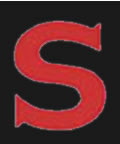 nickname, "The Little Blackbirds."
nickname, "The Little Blackbirds."
In 1891 and 1892, Singers won the Birmingham Junior Cup twice in succession and on the back of this success were admitted to the Birmingham & District League in 1894. In 1898, Singers FC became Coventry City and a year later the club moved into their present home at Highfield Road. Despite mediocre performances, Coventry achieved election the Southern League in 1908, having reached the second round of the FA Cup the previous season. After a disastrous first season, Coventry went all the way to the FA Cup quarter-finals in 1909. There was little further progress and when the First World War brought the suspension of professional football, Coventry were languishing in the Second Division of the Southern League.
In 1919, the Football League was expanded and Coventry succeeded in being elected to one of the vacant positions. For 12 years the club fought against relegation on the pitch and boardroom instability off it. As an experiment, the club briefly adopted the municipal colours of red and 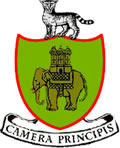 green in March 1922, painting the offices and stands to match. The crest based on that of the city of Coventry was worn on the halved shirts. Finally, in 1925, Coventry were relegated to Division Three (North). A year later they were transferred to the southern section and they remained there until 1936.
green in March 1922, painting the offices and stands to match. The crest based on that of the city of Coventry was worn on the halved shirts. Finally, in 1925, Coventry were relegated to Division Three (North). A year later they were transferred to the southern section and they remained there until 1936.
In 1937, with the club now in Division Two, complaints in the local press about the scruffy state of players' blue and white halved shirts led to the introduction of distinctive new blue shirts with a broad white stripe and white sleeves. Although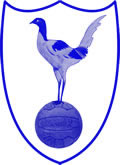 these were replaced after World War Two, this unusual design was revived in the mid-Fifties. In 1952, City were relegated back into Division Three (South) and in 1958 they were placed in Division Four when the regional divisions were scrapped, achieving promotion after only one season.
these were replaced after World War Two, this unusual design was revived in the mid-Fifties. In 1952, City were relegated back into Division Three (South) and in 1958 they were placed in Division Four when the regional divisions were scrapped, achieving promotion after only one season.
In 1959, Coventry retired their blue and white shirts, now considered old-fashioned, and wore all-white instead with an unusual V inset attached to the crew neck of the shirts. For the first and last time, a crest bearing a bantam cock was worn, representing the team's official nickname at the time, "The Bantams." (The image on the right is an approximation of this crest.)
In November 1961, the flamboyant Jimmy Hill was appointed manager. As general secretary of the Professional Footballers' Association, Hill had led the campaign that brought about the abolition of the maximum wage. He now set about a root and branch reorganisation of Coventry City. A new all-sky blue strip was introduced, the first time that matching shirts and shorts were worn (aside from white). Meantime the ground was modernised, young fans were encouraged to meet the players and collect autographs while chartered "Sky Blue Special" trains took fans to away fixtures. Hill proved to be just as shrewd with his players, leading them to the Third Division championship in 1964 and then in 1967, City clinched the Division Two title.
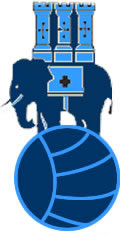 Two days before their first ever game in Division One, Hill left to start a new career in television and most pundits wrote off the club's chances of retaining their place at the top. The Sky Blues proved to be inveterate survivors, surviving relegation scraps year after year. Three times they appeared in the top seven (1970, 1978 and 1989) and in 1987 they had their finest hour, when they came from behind to beat Spurs and win the FA Cup, the clubs only major trophy.
Two days before their first ever game in Division One, Hill left to start a new career in television and most pundits wrote off the club's chances of retaining their place at the top. The Sky Blues proved to be inveterate survivors, surviving relegation scraps year after year. Three times they appeared in the top seven (1970, 1978 and 1989) and in 1987 they had their finest hour, when they came from behind to beat Spurs and win the FA Cup, the clubs only major trophy.
In 1969 navy trim was introduced to the all-sky blue strip, replacing the royal blue previously used. A new crest was also adopted, featuring the elephant and castle from the Coventry coat of arms. This popular motif appeared in black between 1972 and 1975, when the team played in sky blue and black, and a little later, in white and navy.
In 1975, Jimmy Hill returned to the club as Managing Director and later, Chairman, roles that he combined with his successful career as a TV commentator and pundit.
Coventry have always been innovative in their choice of playing strips. The most controversial was the so-called "Talbot 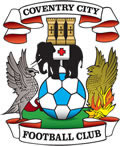 strip" of 1982. Shirt sponsorship had recently been accepted by the Football League but was banned in matches televised by the BBC. The blatant use of the Talbot logo as the main theme of the strip led to the BBC refusing to cover City's matches until they introduced an alternative strip worn only when the cameras were present. It is well documented that, had Hill had his way, the club would have been renamed "Coventry Talbot" at this time.
strip" of 1982. Shirt sponsorship had recently been accepted by the Football League but was banned in matches televised by the BBC. The blatant use of the Talbot logo as the main theme of the strip led to the BBC refusing to cover City's matches until they introduced an alternative strip worn only when the cameras were present. It is well documented that, had Hill had his way, the club would have been renamed "Coventry Talbot" at this time.
To coincide with the club's centenary in 1983, a new crest was adopted. This combined elements from the city crest 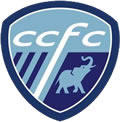 (including the ubiquitous elephant and castle with a football motif.
(including the ubiquitous elephant and castle with a football motif.
In 2001, Coventry's 34 year stay in the top flight came to an end when relegation to (Nationwide) Division One finally overtook the club. Only three other clubs have stayed at the top level for longer.
After 106 years at Highfield Road, the club relocated to the 32,600 capacity Ricoh Arena in 2005. To mark the occasion, the club's board announced that a new, modern crest would be introduced for the new 2005-06 season. The design met with universal disapproval from supporters and after a vigorous campaign, the board was forced to back down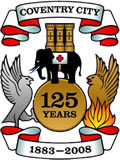 .
.
In 2007 the club faced a financial crisis and narrowly avoided entering administration when Ray Ranson, a former professional footballer who had gone on to make a fortune out of insurance and sports finance, bought the club and installed himself as chairman.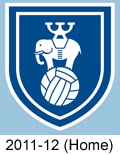 The following year the club celebrated its 125th anniversary. Rather than repeat the mistake of the previous board, the club consulted its supporters on the design of the commemorative crest that would be worn through the 2008-09 season.
The following year the club celebrated its 125th anniversary. Rather than repeat the mistake of the previous board, the club consulted its supporters on the design of the commemorative crest that would be worn through the 2008-09 season.
For the 2011-12 season the club introduced a special crest based on the elephant and football design popular in the Sixties. This was worn on the home kit only and just for one season.
